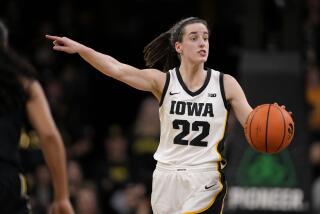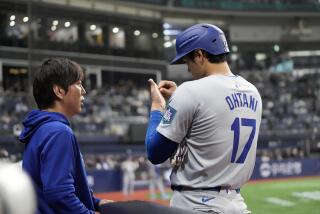Shoemaker Carries on His Trial Without Doctor, Witness, Friend
- Share via
The specter of Robert Kerlan hangs over the Bill Shoemaker trial, as noticeable as a blimp at the Super Bowl.
Kerlan was Shoemaker’s doctor and one of his best friends. The night of Shoemaker’s near-fatal car accident six years ago, Kerlan broke the news to Cindy Shoemaker, then married to the former jockey, that his chances of survival were marginal.
Cindy Shoemaker was in Ohio, at a horse show, the night Shoemaker’s Ford Bronco II went down a steep embankment in San Dimas, rolled over at least three times and landed upright on another highway.
Kerlan, about eight hours after the accident, also told Shoemaker’s family and friends in a hospital waiting room that he was a quadriplegic.
Shoemaker, whose training career has continued even though he can’t use his arms and legs, is suing the hospital and seven doctors who treated him for more than $50 million. The jury trial began last month in Los Angeles County Superior Court.
By many accounts, Kerlan would have been an important witness for Shoemaker, but the 74-year-old orthopedic surgeon died last September after a long illness.
“I think Dr. Kerlan would have been Bill Shoemaker’s best witness,” said Christopher Hiddleson, an attorney for the State of California’s Dept. of Transportation. The state, originally included as a defendant, was excused from the case by Judge Frederick J. Lower Jr. shortly before the trial began.
Neil Papiano, one of the partners in the law firm representing Shoemaker, said Kerlan would have been an asset.
“He could have been a significant part of our case,” Papiano said.
Kerlan, who died of pneumonia, had been plagued by painful rheumatoid arthritis for 50 years. He had undergone four hip replacements, moved about with crutches since 1977 and suffered a heart attack in 1994.
“We would like to have deposed Bob,” Papiano said. “But he didn’t have the strength to give a long deposition.”
Kerlan did give a declaration that contained some of his opinions, but that is inadmissible because the defense attorneys would be unable to cross-examine him.
Papiano tried to use the side door the other day in court, asking Celedonio Fernando, one of the doctors being sued, to share with the jury the conversations he had with Kerlan the night Shoemaker was treated for his broken neck and other injuries at Glendora Community Hospital.
Kenneth N. Mueller, a defense attorney, objected.
“Robert Kerlan is deceased and cannot testify,” Mueller said. “It’s argumentative and improper to introduce anything he might have said.”
Papiano didn’t mention Kerlan during the rest of his questioning of Fernando.
In a three-hour deposition given by Shoemaker in 1992, there were brief mentions of Kerlan:
Question (by Hiddleson): Did Dr. Kerlan ever indicate to you that he thought one of the doctors who treated you at Glendora Hospital or Inter-Community [Medical Center in Covina] had improperly treated you in some way?
Answer: Well, he said they didn’t use the right procedure or something.
*
Q: Do you recall how long after the accident Dr. Kerlan told you that?
A: No.
*
Q: Do you recall where this conversation took place?
A: Right off-hand, no, I don’t. Probably in his office. I’m not sure.
In another place, these questions asked by H. Gilbert Jones, who represents one of the doctors:
Q: You indicated that Dr. Kerlan said that some doctors didn’t use the right procedures?
A: I did indicate that.
*
Q: And tell me more specifically about what he said to you.
A: That’s about all he said. He didn’t tell me any specifics.
*
Q: Did you recognize what doctors he was talking about?
A: No. He didn’t tell me.
And again, these questions asked by Robert C. Reback, a defense attorney:
Q: Is Dr. Kerlan still your principal physician?
A: Well, he’s an orthopedic surgeon. He doesn’t do much anymore, except he doesn’t operate, but he’s there every day, and I go see him when I have any kind of problems.
Kerlan was always there for Shoemaker, either professionally or when there was a practical joke to be pulled. Figuratively, Shoemaker was the guy who would go to all fours behind you, while Kerlan was the guy who would give you the nudge up front. Many of their pranks were on one another.
Even during Shoemaker’s most dire time, there was levity.
It started several hours after the accident. Kerlan was trying to instill in the former jockey the same gameness that he showed on the racetrack.
“You may not make it,” Kerlan said. “And if you do, your life will never be the same. But if you haven’t got it in you, I’ll pull the plug.”
If Shoemaker didn’t blink his eyes, that was supposed to be the signal that he wanted to go on.
Shoemaker’s eyes remained wide open, and after Kerlan left the room he said, “I don’t know what I would have done if he had called my bluff.”
A week later, Kerlan was asked about this.
“Let me tell you something,” Kerlan said, laughing. “Shoe told me that he didn’t hear a word I said.”
In 1987, on a recommendation from Kerlan, Shoemaker, then 56, underwent arthroscopic surgery on a knee and resumed riding two weeks later.
“The surgery was the result of a [thighbone] injury he suffered about 20 years ago,” Kerlan told the Thoroughbred Record in 1990. “His chart is about as thick as Jerry West’s or Pat Riley’s.”
West and Riley of the Lakers were only two of the hundreds of sport figures Kerlan treated. At various times, Kerlan was a consultant to the Dodgers, Angels, Rams, Kings and Lakers. He was the medical director at Hollywood Park and the national medical advisor for the Jockeys’ Guild, an organization that Shoemaker once served as president.
The son of a country doctor from Minnesota, Kerlan raced horses off and on, starting in 1958, about the time he began treating Shoemaker and jockey Johnny Longden.
Kerlan dealt mostly in claiming horses, but Shoemaker rode Royal Captive, the doctor’s first stakes winner, in 1982. Another Kerlan runner, Speedratic, earned close to $500,000.
Like the most basic horseplayer, Kerlan thirsted just to cash a bet. He went through life in search of the horseplayers’ nirvana, a pick-six ticket that paid off in six figures.
Attorney Jones isn’t as certain as others that Papiano really wanted Kerlan’s testimony.
“It might have cut both ways,” Jones said. “This accident happened six years ago, and you would have thought that they would have had time to depose him. Yet they didn’t, and you wonder why they didn’t.”
As Shoemaker’s crony, Kerlan might have taken the witness stand wearing subjectivity on his sleeve, which could have blunted his testimony. But as a man who treated Sandy Koufax, Wilt Chamberlain, Joe Namath and dancers Rudolph Nureyev and Mikhail Baryshnikov, Kerlan at the very least would have commanded the jury’s attention.
In one of the opening statements at this trial, a defense attorney called Kerlan “a world-renowned orthopedist.” A man on crutches testifying on behalf of a man in a wheelchair, and both of them paradigms of their professions? Juries have melted over much less.
More to Read
Go beyond the scoreboard
Get the latest on L.A.'s teams in the daily Sports Report newsletter.
You may occasionally receive promotional content from the Los Angeles Times.










